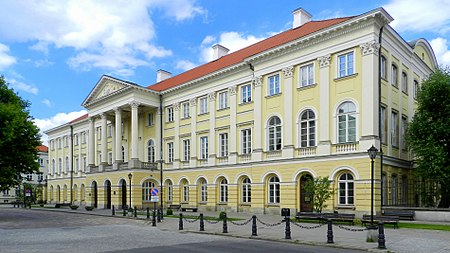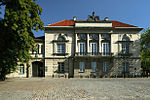Kazimierz Palace
1641 establishments in the Polish–Lithuanian CommonwealthArt and cultural repatriationBuildings and structures in Poland destroyed during World War IIHouses completed in 1641Neoclassical architecture in Warsaw ... and 5 more
Palaces in WarsawRebuilt buildings and structures in PolandResidences of Polish monarchsRoyal residences in PolandUniversity of Warsaw

The Kazimierz Palace (Polish: Pałac Kazimierzowski) is a rebuilt palace in Warsaw, Poland. It is adjacent to the Royal Route, at Krakowskie Przedmieście 26/28. Originally built in 1637-41, it was first rebuilt in 1660 for King John II Casimir (Polish: Jan II Kazimierz Waza, from whom it takes its name) and again in 1765-68, by Domenico Merlini, for the Corps of Cadets established by King Stanisław II Augustus. Since 1816, the Kazimierz Palace has served intermittently as the seat of Warsaw University (which was closed by the Russian Imperial authorities after each Uprising on the part of their Polish subjects, and in 1939-44 by the Germans).
Excerpt from the Wikipedia article Kazimierz Palace (License: CC BY-SA 3.0, Authors, Images).Kazimierz Palace
Romualda Traugutta, Warsaw Śródmieście (Warsaw)
Geographical coordinates (GPS) Address Website Nearby Places Show on map
Geographical coordinates (GPS)
| Latitude | Longitude |
|---|---|
| N 52.240555555556 ° | E 21.020277777778 ° |
Address
Uniwersytet Warszawski
Romualda Traugutta
00-067 Warsaw, Śródmieście (Warsaw)
Masovian Voivodeship, Poland
Open on Google Maps










